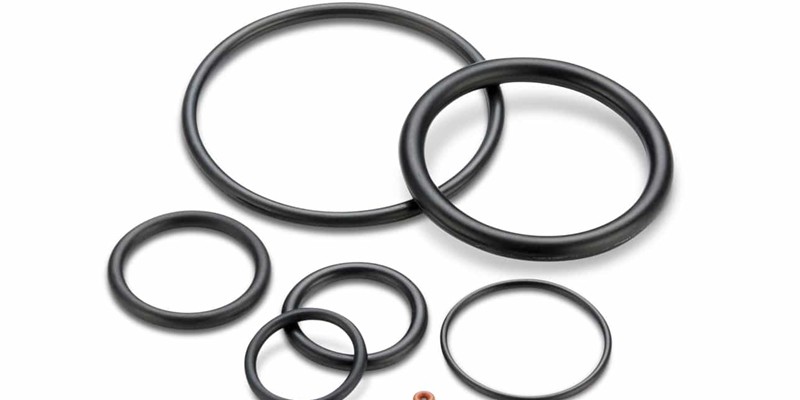- May 19, 2023
O-rings are a key sealing component in machine design with widespread applications in different industries. They provide excellent sealing against high-pressure fluids and can maintain their performance in adverse working environments.
In this article, we will decipher the question of what is an O-ring, O-ring groove design, types, and materials. Furthermore, we will also go over some basic O-ring calculations.
What are O-Rings?
O-rings are mechanical seals that provide high-quality sealing between two mating surfaces. This means that they are responsible for blocking the flow of things from one side of the seal to the other. Consider a pump for example. Its outlet contains high-temperature, high-pressure fluids which can easily escape to the low-pressure compartment, decreasing the pump’s efficiency. Installing O-rings at locations where the fluid can leak prevents this by providing a strong seal.
In addition, O-rings come in the shape of a ring, most often with a circular cross-section. They are generally manufactured with a flexible elastomer as flexibility is the most important material property for O-rings to work efficiently.
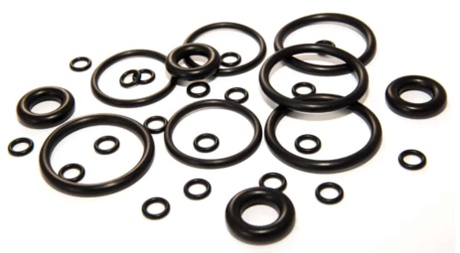
O-rings also can provide both static and dynamic sealing. In a static seal, both mating surfaces are stationary while in a dynamic seal, there is relative motion between them.
Working Principle of O-Ring Groove/Land
The working principle of the O-ring groove design is simple. The assemblage of both mating surfaces squeezes the O-ring in between them, creating a tight seal. To facilitate this, the inner mating component has a groove machined into its surface at the spot where sealing is required. Engineers call this groove the O-ring groove (O-ring gland).

The O-ring groove dimensions require the O-ring to slightly stretch to achieve a sturdy O-ring fit in the groove, quite similar to a snap-fit joint. Moreover, the diameter of the O-ring is intentionally kept slightly larger than the depth of the O-ring groove size, which causes it to extend beyond the mating surface.
This extended part comes in contact with the outer mating surface when it is assembled. The assembly pressure compresses the O-ring to such an extent that it partially fills up the O-ring groove (O-ring gland) and seals the gap between both surfaces. This gap is another important design consideration. Engineers use the term ‘clearance gap’ to describe it.
Types of O-Ring Groove/Gland
The o-ring groove (O-ring gland) is the most important design feature for producing efficient O-rings. They come in different shapes and sizes depending upon the exact applications. We highlight some of the main O-ring groove types here.
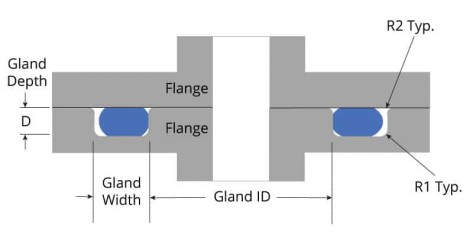
Flange/Face Seal Groove
The flange seal groove is the most common and simple among the O-ring groove types. The groove is rectangular in shape and has no gap between the mating surface. Thus, there is direct surface-to-surface contact, eliminating any issues related to ring extrusion gaps.
Moreover, flange seal groove is a static O-ring groove design suitable for non-moving components. The table below shows the recommended O-ring groove dimensions for different sizes as per AS568 standards.

Dovetail Groove
The dovetail groove has inclined sidewalls, making it look like a dovetail, hence the name. The wall inclination creates a groove with a trapezium cross-section, whose main purpose is to hold the O-ring in during installation and maintenance. This design is suitable for static sealing. Moreover, the locking capability makes the dovetail groove ideal for applications with regular disassembly and maintenance, allowing for less downtime and quicker handling.
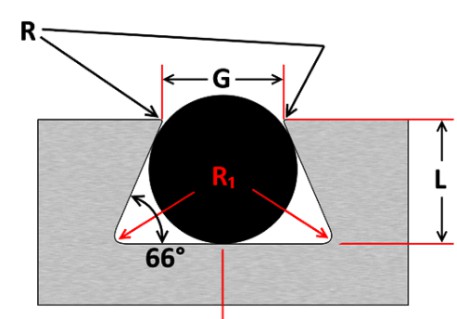
However, designers must be careful in selecting the dovetail groove dimensions as a large inclination angle can limit the space inside the groove for the O-ring to expand into. If this is the case, lack of space can damage the O-ring and affect the quality of sealing. The table below summarizes the recommended dimensions of a dovetail O-ring groove (O-ring gland) for various O-ring sizes.
| O’ring CS | Groove Depth (L) | Squeeze (%) | Groove Width (G) | Retainer Radius (R) | Groove Radius (R₁) |
| 0.07 | .053 – .055 | 23 | .057 – .061 | 0.005 | 0.015 |
| ±.003 | |||||
| 0.103 | .081 – .083 | 21 | .083 – .087 | 0.01 | 0.015 |
| ±.003 | |||||
| 0.139 | .111 – .113 | 20 | .113 – .117 | 0.01 | 0.031 |
| ±.004 | |||||
| 0.21 | .171 – .173 | 18 | .171 – .175 | 0.015 | 0.031 |
| ±.005 | |||||
| 0.275 | .231 – .234 | 16 | .231 – .235 | 0.015 | 0.062 |
| ±.006 | |||||
| 0.375 | .315 – .319 | 16 | .315 – .319 | 0.02 | 0.093 |
| ±.007 |
Half Dovetail Groove
The half dovetail groove is a special groove with only one inclined sidewall. It is a compromise between the design advantages of the flange seal groove and the retaining capability of the dovetail groove. Thus, it offers the benefits of both, but to a balanced degree. For example, in applications where the O-ring operates in a vacuum, the O-ring is pulled to one side of the gland. In this case, the flat side of the half-dovetail groove is perfect for holding the O-ring while the inclined side keeps it inside the groove.
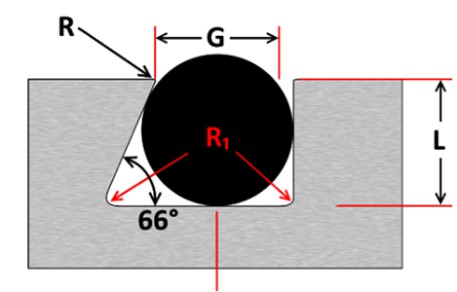
As before, the table for recommended dimensions is given below.
| O’ring CS | Groove Depth (L) | Squeeze (%) | Groove Width (G) | Retainer Radius (R) | Groove Radius (R₁) |
| 0.07 | .053 – .055 | 23 | .064 – .066 | 0.005 | 0.015 |
| ±.003 | |||||
| 0.103 | .083 – .085 | 19 | .095 – .097 | 0.01 | 0.015 |
| ±.003 | |||||
| 0.139 | .113 – .115 | 18 | .124 – .128 | 0.01 | 0.031 |
| ±.004 | |||||
| 0.21 | .173 – .176 | 17 | .190 – .193 | 0.015 | 0.031 |
| ±.005 | |||||
| 0.275 | .234 – .238 | 15 | .255 – .257 | 0.015 | 0.062 |
| ±.006 | |||||
| 0.375 | .319 – .323 | 14 | .350 – .358 | 0.02 | 0.093 |
| ±.007 |
Triangular Crush Groove
This design has a triangular cross-section with the groove machined into one of the mating components. It allows for a simple, cheap grooving process with adequate sealing capacity. The seal is static and also non-reusable. If it is subjected to extreme, uneven compression can permanently deform the O-ring. The O-ring groove dimensions recommended by design engineers are given below for different O-ring cross-section sizes.
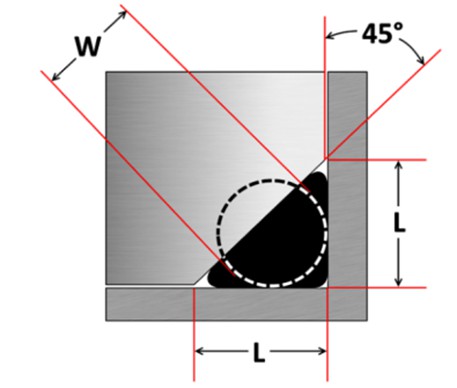
| Cross Section (W) | ± | Groove Depth (L) | ± (-0) |
| .070″ | ±.003″ | 0.092″ | +.003″ |
| .103″ | ±.003″ | 0.136″ | +.005″ |
| .139″ | ±.004″ | 0.184″ | +.007″ |
| .210″ | ±.005″ | 0.277″ | +.010″ |
| .275″ | ±.006″ | 0.363″ | +.015″ |
| 1.50mm | ±0.08mm | 1.98mm | +0.08mm |
| 2.00mm | ±0.08mm | 2.64mm | +0.08mm |
| 2.50mm | ±0.08mm | 3.30mm | +0.13mm |
| 3.00mm | ±0.10mm | 3.96mm | +0.13mm |
| 4.00mm | ±0.13mm | 5.28mm | +0.18mm |
O-Ring Groove ID/OD Design Considerations
The inner diameter (ID) and outer diameter (OD) are important O-ring groove dimensions as they determine the nature of the interaction between the O-ring and the mating surfaces. Moreover, they are also useful in controlling the compression and friction forces the O-ring experiences.
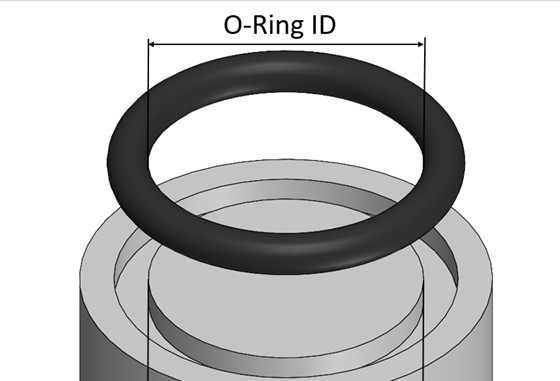
For the ID, experts recommend keeping it 1%-5% smaller than the outer diameter of the O-ring groove (O-ring gland). This allows for the slight stretch of the O-ring during the installation we mentioned at the start.
The OD should ideally be larger than the gland depth by a small amount. This allows achieving proper O-ring compression to occur post-installation. The goal is to have around 1%-3% compression.
O-Ring Groove/Gland Depth & Width Design Considerations
The O-ring groove (O-ring gland) width and depth are critical dimensions for the performance of the O-ring since they determine its void volume and general shape.
The depth must be smaller than the O-ring diameter by the amount of clearance gap recommended by the manufacturer. This is necessary as a low depth can over-compress the bearing while a larger depth can lead to extrusion issues. Extrusion refers to the event when the clearance is so large that a significant portion of the O-ring gets sucked into it, creating unwanted stresses, and damaging the O-ring.
Similarly, the width of the gap is also important for O-ring groove dimensions. An extra wide groove increases costs and can accumulate fluid, which might create extra pressure on the sealing interface. A small width has the same effect as a small height: over-compression.
Furthermore, both the O-ring groove width and depth determine the overall housing fill of the O-ring assembly. The fill is the amount of the groove cross-section taken up by the O-ring after assembly. The O-ring groove dimensions must be set such that the fill is a maximum of 85%.
O-Ring Cross-Sectional Area
The cross-sectional area of O-rings depends on their width (the diameter of their cross-section). O-rings with smaller cross-sections are generally cheaper to produce and are lightweight, but they are more prone to a high compression set. This means that they get deformed more inside the groove.
A larger cross-section, although voluminous, has a lower compression set and is more robust. However, the surface friction is high due to a larger contact area with the groove walls.
O-Ring Compression Set (Squeeze)
The compression set (squeeze) is a critical design consideration in O-ring groove design. Geometrically, it is the difference between the cross-sectional width of the O-ring and the gland height. In other words, it is the length by which the assembly squeezes the O-ring.

If the O-ring groove size has a large squeeze, there is a risk of over-compressing the O-ring, which can lead to permanent deformation or even failure to create adequate sealing. On the contrary, a smaller compression can is also problematic as it may not create enough surface traction to create the seal.
O-Ring Groove Materials
The material choice in O-ring design is another crucial decision. Since O-rings largely depend on their flexibility, the catalog of viable material choices is limited to elastomers. However, there are many elastomers to choose from and designers must be knowledgeable about them to make informed decisions.
Nitrile Rubber
Nitrile rubber is the most common choice of material for O-rings. It comes in various grades that differ in the composition of acrylonitrile. It has high abrasion resistance, strong mechanical strength, and resists well against gas permeation and compounds like mineral oils and greases.
Moreover, it is also suitable for a wide temperature range going up to 130℃.
Silicone Rubber
Silicone is another popular material for manufacturing O-rings. It is resistant to various harmful environments such as ozone, UV, oils, and hot air. Moreover, it has great temperature resistance and retains its mechanical properties, including flexibility, up to 230℃.
However, its drawbacks include poor strength and wear/tear resistance. This makes it suitable only for static sealing applications.
Thermoplastic Polyurethane
Polyurethane is an ideal candidate for extreme working conditions like high-pressure sealing. It boasts high toughness, abrasion resistance, and thermal stability.
On the negative side, it can lose its properties in environments containing acids, chlorinated hydrocarbons, and humidity.
Fluoroelastomer
Fluoroelastomers are good choices for O-rings due to their chemical inactivity against most potentially harmful compounds. Furthermore, fluoroelastomers have a smooth surface with self-lubricating qualities, making them perfect for applications where a lubrication system is difficult to set up.
However, they are susceptible to mechanical creep over time.
Other O-Ring Materials
The complete range of O-ring materials is infeasible to cover in this article due to its length. Hence, a comprehensive list of other main materials is shared below:
- Cholorprene
- Ethylene Propylene
- Perfluoroelastomer
- Polyacrylate Rubber
- Hydrogenated Nitrile Rubber
- PTFE (Teflon)
- PEEK
Advantages of O-Rings Groove
The O-ring groove (O-ring gland) has numerous benefits over other sealing methods. We briefly touch upon these benefits below.
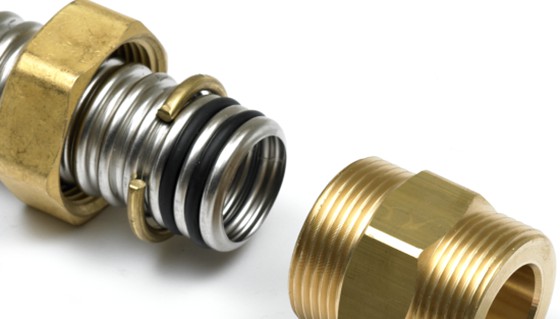
Reliable Sealing
O-rings are, without a doubt, highly reliable seals. With so many O-ring groove types and materials, designers can pick the best combination for their sealing applications. O-rings rarely fail, have a long service life, and can operate in tough conditions, which is enough to rank them in high-end sealing solutions.
Compact Installation
Among conventional sealing solutions, the compact geometry of the O-ring groove design stands out. Gaskets require a large surface area, and labyrinth seals require extra hardware and space, but O-rings take up minimal space in an assembly and are easy to install.
Lightweight
A major advantage of O-rings is their negligible mass. They are small rings of rubber that hardly add any weight to the assembly but provide good sealing.
Variety of Designs and Materials
The immense variety in material choices and the versatility of O-ring groove design have been discussed above, but we would like to reiterate this point as another huge benefit. Generally, such variety is not available to design engineers, and it is a luxury that they have several options to pick from for such an essential application.
Bonus: How to Calculate O-Ring Gland Dimensions
The previous sections discuss in detail the dimensions of the O-ring groove (O-ring gland). In this section, we expand upon those points and offer some advice on calculating the main O-ring groove dimensions, which are the gland height and width.
O-Ring Groove Height
The main parameters determining the O-ring gland height are the preferable amount of compression ratio and the cross-sectional width of the O-ring. Since these two are linked, the formula derives from their shared relationship.
Gland Height = Cross Section Width – ( Compression Ration – Cross Section Width )
The third input is the compression ratio, which is a design decision. Ideally, engineers try to design an assembly with an approximate compression ratio of 20%.
O-Ring Gland Width
The major parameters influencing the O-ring gland width are the O-ring cross-sectional area and the desired fill volume. We suggested that the O-ring fill must be below 85% in a previous section. Keeping this in mind, engineers normally target a value between 50%-85% based on their application, material choice, temperature conditions, etc.
The generalized formula for O-ring gland width:

Note that this is not the direct formula for the O-ring gland width but a general guide for designers to get acquainted with the basic geometry of the O-ring groove design. In reality, there are numerous correction factors for variables like thermal expansion that fine-tune the calculations.
Conclusion
O-rings undoubtedly hold a fundamental value in machine elements and are the go-to sealing solution for most engineering applications. This article comprehensively covered the O-ring groove (O-ring gland), from its purpose to design to materials. As an extension, we also shared some basic design tips and formulae.
FAQs
How to select an O-ring size?
The dimensions of the components requiring the sealing are used to select the O-ring size. The ID must be slightly smaller than the shaft diameter to achieve some stretching while the outer diameter should also roughly match the outer diameter of the O-ring.
What causes O-ring failure?
There are numerous ways O-rings can fail. Physical damage in the form of over-compression, extrusions, and general wear and tear can lead to failure. Moreover, if the O-ring material is exposed to chemicals which it is not compatible with, it can degrade due to chemical reactions and fail.
How to install O-rings?
The O-ring is carefully slid into its groove with ease during installation. It may require some lubrication if the fit is tight. Also, it is advisable to avoid sharp edges/corners and take care while sliding the O-ring over threaded portions.

